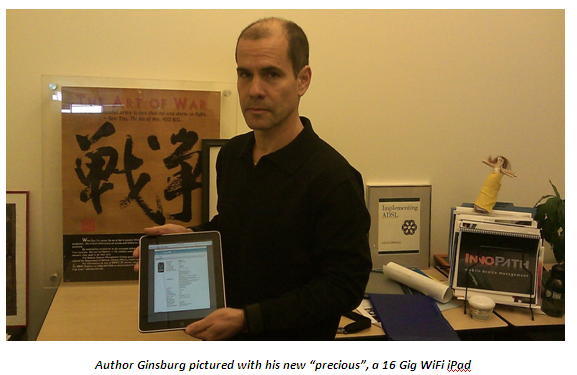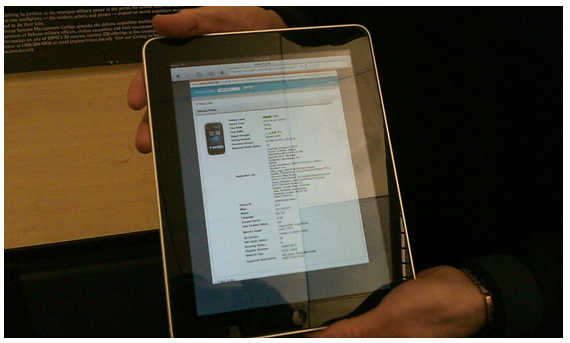By now you've probably read a dozen or so reviews of the iPad, most generally positive though a few holdouts don't see the need for 'yet another device.' I'll admit… I'm an Apple (News - Alert) fanboy, and the iPad I purchased is the first of three that we'll eventually own. But I'm selective. My phone is a Blackberry 9700, though I do carry an iPod Touch for media (though possibly not for long!). So, rather than gush over the coolness of the apps or the build quality, I'll focus on two areas that I think will take center-stage in our understanding of the iPad's impact. The first is what I call the 'iSurface,' borrowing from Microsoft's (News - Alert) well received but as of yet un-productized Surface computer, and the second is how it will redefine mobile data consumption.
If you remember, a few years back, Microsoft introduced the Surface. Fast forward, and even before the launch of the iPad (mine, pictured with me, below), the press is already writing its obituary, or at least mourning its non-birth. However, I don't think its death is due to execution problems within Microsoft or lack of proper marketing…. I'd peg it to a lack of understanding as to where and how users now interact, a lack of understanding which has been manifested in mis-execution (until recently with the Window Phone (News - Alert) 7, also as of yet unborn) in the whole mobile space.

The concept of the surface was great, but it was too 'large' and 'tied down' for Generation's Y and Z, the digital nomads. Heck, they don't even want landlines in many cases, a sentiment that it seems that even the service providers share. What Apple did with the iPad, either knowingly or by default, was to create the first mobile surface, the iSurface. Take it on-the-go, connect to WiFi or 3G, and game-on. I didn't experience this firsthand until I witnessed my 5 and 7 year old girls playing checkers and LineUp (a Tetris-like game). This after only fifteen minutes on the day before Easter (and I'm not inferring any hidden agendas on the release date). Pair the pad with more sophisticated games that use the iPod Touch or iPhone (News - Alert) as a controller, and you see where this is going with poker, bridge, and other board games. Or a restaurant, dispensing with paper menus, and just leaving the device on the table for re-orders (an animated 'Hi, I'm your host Camella the Cow, and I'd like to offer you the juicy bits…') So, what does the iSurface imply for bandwidth consumption.
Here in Silicon Valley, and working in the mobile space, we're sometimes a bit too close to the binary stars of Apple and Google. But across the population as a whole, iPhone or Android (News - Alert) toting 20-somethings are still the minority. Canalys pegs the combined population of these two OSs in NA at just over 25 million by the end of 2010, or about 7 percent of the US and Canada. Definitely not the majority. What about the other 93 percent of us? I was explaining the meaning of the iSurface to one of my friends over the weekend, and teased out the differentiation with the laptop. The latter is OS centric, pulled out for work, and many times shoved aside for the weekend. Apple's invention, on the other hand, is application-centric, and as they've stated, a media consumption device. The first wireless media consumption device, and here is where things get interesting. I personally think it will hit an entirely new demographic, with penetration way beyond that of the smartphone.
Traditional laptop WiFi, and to a lesser extent, 3G connectivity is relegated to the mobile business crowd (vs when used in the home). iPhones and Androids, except for a small majority who are mind-melded to the devices, can only consume so much data in a 24 hour period. I figure it to be about 150-200 MB based on personal experience. But the iPad…. a few hours on Netflix or ABC.com, and you see where it is going. 500MB+ in a day is not unreasonable given 300MB/hour for reasonable quality streaming (understanding that an hour of DVD-quality MPEG-4 is about 1.2GB). Cut back on quality, and you might limit this to 100MB/hour, but that is probably the absolute minimum. So, a user could consume anywhere from 5 to 15GB per month. If most of this is over 3G, it will have serious network implications.
It will be interesting to see what percent of iPads are equipped with 3G, and whether AT&T's $30/month unlimited 3G access holds true to its name. For their sake, I sure hope that the handover from 3G to WiFi is seamless, helping to offload the more limited cellular infrastructure. Or, the spell cast by my kids' fixation with the Wizards of Waverly Place, streamed via Netflix to the device, may have the same impact on the network that as Avada Kedevra had on a few poor unfortunates in Harry Potter.
Speaking of changing the world, here's a screenshot of InnoPath's ActiveCare, running on the iPad, diagnosing the ills of a Windows Mobile 6.5 device over-the-air:

David Ginsburg is vide president of marketing at Innopath Software.Edited by Michael Dinan
 Internet Telephony Magazine
Click here to read latest issue
Internet Telephony Magazine
Click here to read latest issue CUSTOMER
CUSTOMER  Cloud Computing Magazine
Click here to read latest issue
Cloud Computing Magazine
Click here to read latest issue IoT EVOLUTION MAGAZINE
IoT EVOLUTION MAGAZINE




